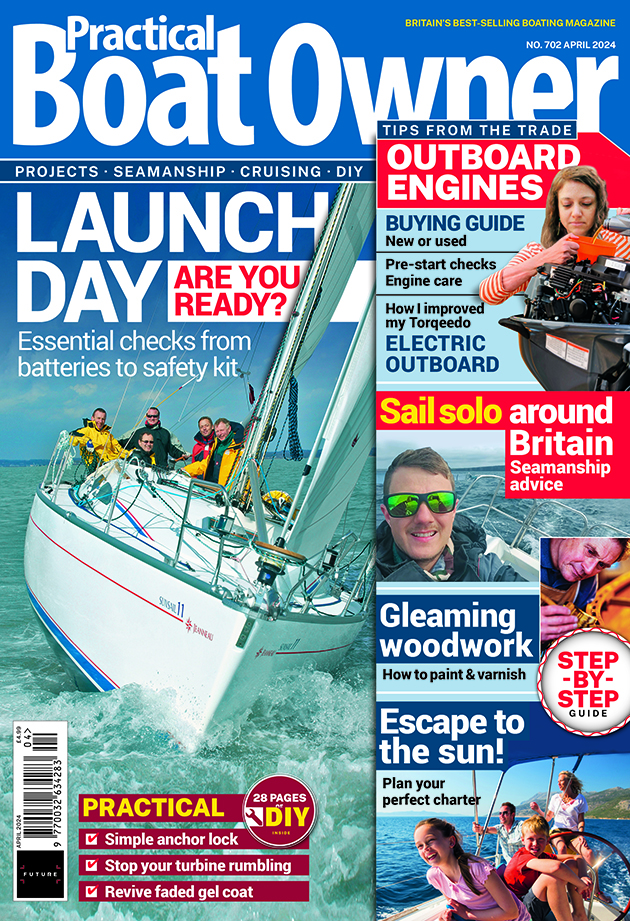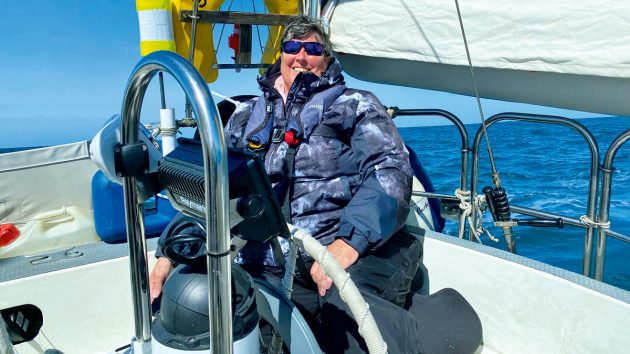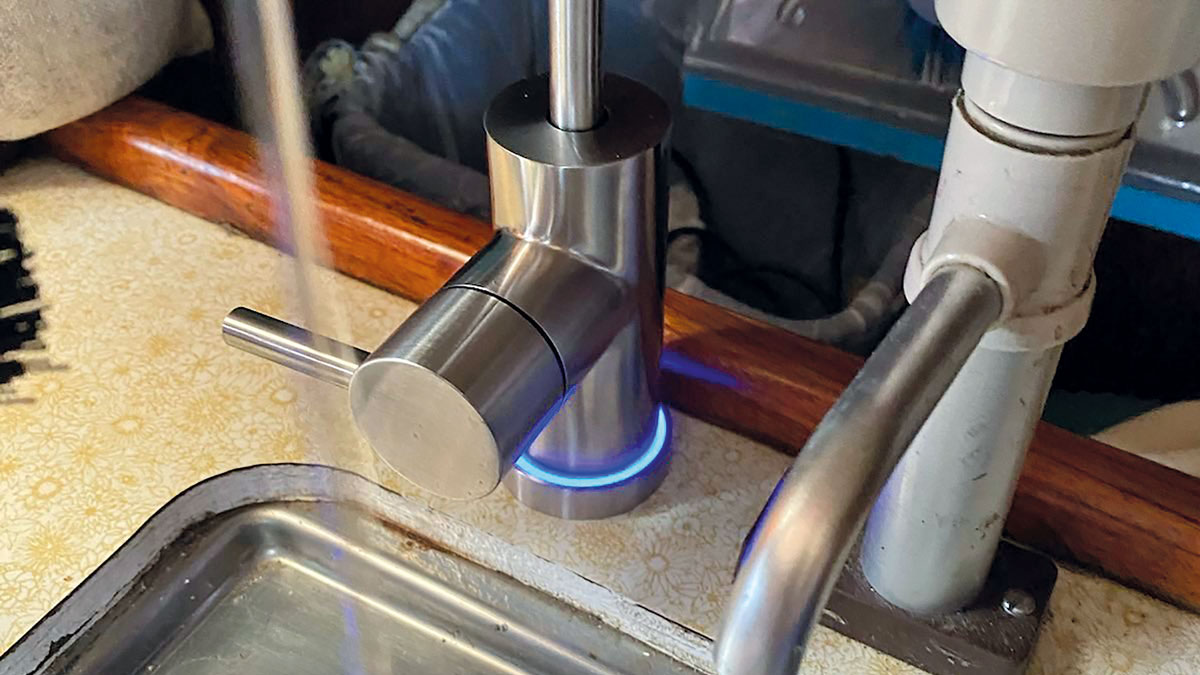Deteriorating mobility has forced Kerry Buchanan to modify habits aboard – but she’s still sailing!
Sailing with limited mobility: a practical guide
Sailing is a sport that can provide thrills and spills if that’s what you enjoy.
But it can also open up a world of tiny harbours and heavenly anchorages for cruisers who prefer a slower pace of life.
Many of us started out as dinghy sailors and gradually moved up in size as family demands or inclination dictated.

Being more careful about picking a good weather window is important as you get less bouncy with age. Credit: Kerry Buchanan
Fraser and I are no exception. Before we met, we’d both been exposed to sailing as teenagers, and as a couple we have owned dinghies, trailer-sailers, then small- and medium-sized cruising yachts.
As relative youngsters, we had neither time nor money for long term cruising, but now we are retired we have both time and a bit of money saved to indulge in our hobby.
But here’s the rub.

Keen small boat sailors with decreasing mobility and poor balance may do well with stable dinghies like the Dockrell 17
Over the years, I’ve developed psoriatic arthritis and Fraser has been through a rough time recently with prostate cancer, which has left him with severe anxiety.
My physical disability and his mental health issues combine to make us a less able team than we used to be.
I’ll mainly discuss the challenges of physical disability here, although other forms also present their own hurdles.

A chartplotter big enough for old-person eyesight is helpful. Credit: Kerry Buchanan
My own mobility began to decrease a couple of decades ago when we were still sailing with three teenagers, a dog, and a cat, so we had our hands quite full.
Gradual onset enabled us to adapt our response as my condition deteriorated.
Key concerns
The issues I, and many older people who sail, face include:
- Painful, inflamed joints. This means you cannot always grip a line firmly enough to haul on it, you become clumsy when using winches, less agile moving around the boat and far less trusting of your body’s ability to keep you upright when the boat heels or dips unexpectedly.
- Problems with balance. With arthritic joints, balance becomes a matter of luck, never quite knowing if a knee or ankle is going to hold you up or give up the ghost and drop you unceremoniously in a heap – usually at a critical moment while tacking or handling lines.
- Decreasing mental capacity. Another natural age change, but this can be magnified by conditions such as dementia, or anxiety such as Fraser is experiencing after his cancer treatment (and exacerbated by the fact that my disability puts a lot of pressure on him). There’s a tendency to make mistakes, for example, when passage planning, which can lead to danger if unnoticed.
- Reduced stamina. In the good old days, we could have kept sailing all day and night and still functioned effectively at the end of the passage, but as age takes a stranglehold, we find ourselves tiring far more easily. Some of this is due to the extra effort required to overcome physical and mental deterioration, but some of it is simply old age.
- Seasickness. This isn’t necessarily connected to age or disability, but it can be debilitating and even tip a difficult situation over the boundary into danger. Side effects from Fraser’s cancer therapy mean he cannot take many of the seasickness remedies available, so all he has is acupressure in the form of wristbands, which are of limited use.
- Loss of confidence is a natural result of all the above, and I should add increased crabbiness, defensiveness, damage to pride, etc. It can put a strain on relationships that have taken years to develop, because the sufferer often doesn’t like to admit, even to themselves, that they are no longer capable of carrying out activities they love.
I found myself becoming reluctant to move around under way, especially in anything vaguely rough.

Barberry has a deep, safe cockpit, and roller furling genoa and main, with all lines led aft. Credit: Kerry Buchanan
Once I had jammed myself into a safe corner, I was too afraid to come out of it.
As for descending the companionway steps to pass up food or drink or use the heads? I haven’t quite resorted to wearing a nappy, but nor am I ruling out the possibility!
Sailing with limited mobility: helpful adjustments
- Role reversal. Fraser had always helmed the boat and I had been the one to rush about, hauling on sheets and making the leap of faith onto unstable finger pontoons while holding a mooring line in each hand. Instead, I started helming and Fraser got to do the athletic stuff. It can be quite hard to admit the necessity for an alteration in roles like this, but a good skipper knows they must make judgements based on the abilities of their crew. I still know how to handle lines, and Fraser is still a great helmsman, but we have adapted and grown, expanding our skills to compensate for changes that cannot be avoided.
- Learning to be patient with each other. I’m not a ‘natural sailor’ in the same way he is. I have to think through every manoeuvre before I carry it out, working through the various scenarios step by step, whereas he steers as if he is at one with the wind and sea. This led to a steep learning curve for me and it is a tribute to Fraser’s patience that he allowed me space to make mistakes and time to find my feet.
- Marina berthing. We’ve developed a technique where neither of us needs to leave the boat until we are secured, which works on most finger pontoons or along-side berths. Fraser drops a line from the boat’s middle cleat to the first cleat on the pontoon, using a boat hook for accuracy. Once it’s adjusted for the length of the pontoon and locked off aboard, I stop the boat gently, then put her in slow forward with the wheel over to spring her in the rest of the way, adjusting revs and angle to keep her there while he takes the bow and stern lines ashore in his own time. On passage, we always try to phone or radio ahead to the harbour or marina we’re aiming for to ensure there is a berth available, and we make them aware that one of us has mobility issues. So far, we have been met with kindness and understanding, and often been given a berth with easier access, or closer to the facilities. Marinas can’t always help, especially in the busier months, but we have found they always do their best.
- New skills. I used to do all the passage planning and navigation, but now Fraser does the same thing in parallel, usually muttering under his breath things like, “So five hours 50 taken away from local high water minus three is…”. Once we’ve each calculated tidal streams, passage timings, ports of refuge, hazards, etc, we compare notes to make sure neither of us has made a mistake or missed anything. It’s a safety net. Sometimes it can take several passes before we’re both happy with our calculations, but so far (touch wood) we’ve been bang onevery time.
- Increased caution. We have become extremely cautious with our weather choices. This leads to other sailors occasionally acting a bit judgy when they are heading out into a blow and we are putting the kettle on, waiting for a better forecast, but that does not bother us. We were young, once, too. We also try to avoid the risk of wind over tide wherever possible, give headlands with tidal overfalls an even bigger margin than usual, plan shorter passages with plenty of boltholes in case one of us is in trouble. Sometimes it can be harder to make the decision to cut short a passage, or, even worse, decide to go back, than it is to just keep going. We have done both, and I have to admit that the mild feeling of failure after we have wimped out and headed for cover instead of fighting headwinds and steep waves. It can put a dent in our pride, but we have to be aware that things can go wrong very quickly, even for fit and able crews. We no longer have the flexibility to manage disasters easily, and we take longer to recover from a rough passage than a young, fit sailor might believe possible. Our weaknesses don’t keep us on the dock, they just cause us to display more caution than we used to when we were young and pain-free. In fact, as I write this, we are on our way from our home berth in Bangor, Northern Ireland, bound for the Mediterranean via the French inland waterways. We’re stuck (very happily) in Neyland Marina in Wales, waiting for favourable winds to cross the Bristol Channel to Padstow. We may be here a while, judging by the weather forecast, but it is April and we are in no hurry. Which brings me to the next point.
- Try to avoid deadlines. That’s one of the advantages to old age. We’re finally retired, we’ve sold our house, moved into a smaller rented bungalow 10 minutes from the boat, persuaded our adult children to pet- and house-sit for us for an undefined length of time (we may have mumbled something about October, but carefully didn’t say which year), and now we’re free to roam. If we stay in Neyland for a week or 10 days, we’ll find plenty to do to occupy our time. Boat jobs, chatting to local sailors, break out the folding bikes (mine is electric assisted, to help with aching knees), or even hobble to a bus stop to see some of the sights South Wales has to offer. I firmly believe that sailing to a deadline is one of the worst enemies of safety. The need to get back to your home port in time for work on Monday, or school for the kids after summer holidays, or because the in-laws are visiting tomorrow can tempt people to take chances with weather and tides. We have done it in our younger days, and I can’t tell you what a relief it is to not have to worry about deadlines anymore.
- Seasickness. On lumpy passages I hand the helm over to Fraser as he would rather stand there, eyes locked on the horizon, than sit facing sideways. It’s exhausting for him, and makes rough crossings a complete misery. Another reason to pick our weather windows carefully.
Sailing with limited mobility: boat choice and set up
This can make a huge difference to safety and comfort.
Our current boat, a Barbican 33, is sea-kindly, doesn’t slam, and can certainly take far worse conditions than her crew is comfortable with, but there will always be a degree of compromise.

The addition of a bow thruster at the helm has reduced stress during berthing and the need to run around. Credit: Kerry Buchanan
For example, Barberry has a steep companionway with six steps that are difficult to manage in big seas whereas a previous Southerly 105 we owned, had an inside steering position, deep centre cockpit and was almost a walk-through from cockpit to cabin.
However, her motion in steep seas was not wonderful for someone prone to seasickness!
Cold makes everything worse, from stiff joints to mal de mer.
In the northern British and Irish waters we normally sail, it can get extremely cold.

A small galley has advantages: it’s easier to strap into it. Credit: Kerry Buchanan
We’re thinking about adding a full cockpit cover to Barberry for warmth.
We also look with envy at boats with a pilot house and remember with regret our inside steering position on the Southerly. Having diesel heating helps, too.
We added this to Barberry a couple of winters ago and when off-watch, we often have our feet stuck to the blown air outlets to defrost.

Good handholds and hip holds are important below. Credit: Kerry Buchanan
A pilot berth with a lee cloth is also a good idea for long passages.
The off-watch crew member needs to be able to rest in safety even if they cannot manage to sleep.
To reduce the necessity for crew to move around the boat under passage, we have all our lines led aft into the cockpit and we have also chosen to have furling foresail and mainsail to save us from having to go forward the mast to reef, or to raise or lower the sails.
When we bought Barberry, these were all essentials on our list.
- A folding step is useful, in case you end up in an awkward space with a big jump up to your boat from the pontoon.
- Emergency devices. We carry personal AIS MOB devices, an EPIRB for the boat, grab bag, liferaft, man overboard sling, etc and made sure we know how to use them.
- Able-bodied crew. Where possible, try to bring a reliable, able-bodied crew member along with you. I say where possible: we hardly ever manage it as our usual able-bodied crew, our son, Patrick, works long hours as a lifeguard and is rarely free to help us out.
- Communication. The final helpful device we’ve added to our cruising necessities is a pair of headsets for communication. These have been a game changer, reducing the stress when coming into a tight berth or anchorage. I can hear Fraser as he calls out distances in his normal speaking voice, or tells me how much chain he has put down. Something about raised voices increases anxiety, and before the headsets we always felt as if we were shouting at each other angrily, and still not being heard. It also helps if you’re arriving or leaving a busy marina in the wee small hours. No neighbours disturbed by our panicky voices!
Forward planning
If you’re reading this and already have a boat, I hope I’ve helped you think about any changes you might wish to make as your age increases or mobility decreases.
It pays to think about these things in advance, preferably with your feet up at home, rather than while you’re making like a tossed salad on the ocean swell.

Barberry in the Mediterranean in 2023. Credit: Kerry Buchanan
If you’re in the market for a boat, perhaps this will help you to choose wisely.
Although I’ve focussed on the challenges of sailing when old and stiff, sailing with young children, and even pets, can provide quite as many challenges, and many of the solutions suggested here can be equally applicable to those situations.

Kerry is willing to keep making adjustments to continue to be able to do something “that brings such pleasure and a sense of achievement”
Despite the challenges we face, we still absolutely love sailing, and it has definitely been worth making a few changes to enable us to continue doing something that brings us such pleasure and a sense of achievement as we slide gracefully into decrepitude.
I’d like to hope we’ll continue to enjoy it for many, many years yet.
Continues below…
Berthing a vessel: 2 clever ways with warps
In these days of fin keels, bow-thrusters and powerful engines, using warps for marina manoeuvres might seem an old-fashioned irrelevance…
Fitting a UV light water filtration system
Kerry and Fraser Buchanan install a UV light water filtration system to make the tank water stored on their Barbican…
How to prepare a small boat for a big offshore sailing adventure: Top tips from Jester Challenge sailors
The art of sailing a small boat single-handed for long periods has been perfected by Jester Challenge sailors. Jake Kavanagh…
Seasickness remedies: 20 ways to fight mal de mer without medication
You never forget your first time. As we left the wind shadow of Rønne on the island of Bornholm, Denmark,…
Enjoy reading Sailing with limited mobility: a practical guide?

A subscription to Practical Boat Owner magazine costs around 40% less than the cover price.
Print and digital editions are available through Magazines Direct – where you can also find the latest deals.
PBO is packed with information to help you get the most from boat ownership – whether sail or power.
-
-
-
- Take your DIY skills to the next level with trusted advice on boat maintenance and repairs
- Impartial in-depth gear reviews
- Practical cruising tips for making the most of your time afloat
-
-
Follow us on Facebook, Instagram, TikTok and Twitter








